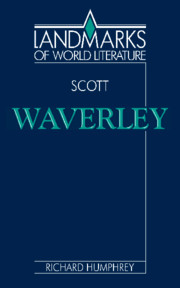1 - Scott's changing world and the making of Waverley
Published online by Cambridge University Press: 27 January 2010
Summary
The Napoleonic years
O who, that shared them, ever shall forget
The emotions of the spirit-rousing time …
The Lord of the Isles, VINapoleonic Europe is to the historical novel what ancient Greece is to tragic drama: both one of its enduring themes and its birthplace. Not only was the turbulence of those years to attract the cream of historical novelists, from Balzac, Stendhal and Thackeray through Tolstoy and Pérez Galdós to Fontane, Hardy and Conrad, but Waverley itself, the inaugurator of the genre, was begun, Scott states, in 1805, just weeks after Trafalgar (or, others suggest, around 1808–10, with the Peninsular War in full flow), resumed in Autumn 1813, on the eve of the Battle of Nations at Leipzig and published in July 1814 less than a year before Waterloo. Indeed, on its day of publication, Thursday, 7 July 1814, the British nation was officially – if prematurely – celebrating peace in Europe.
What a context! But – is it one? Does it in any way help to account for Waverley, and if so, for how much and why?
The circumstantial evidence linking Scott (1771–1832) and Bonaparte is, to be sure, strong. After all, the two men shared the same birthday – Napoleon being just two years Scott's senior – and so took their respective gradus ad Parnassum in step. As the opening chronology details, Scott became a student and advocate between Revolution and 9 Thermidor, a translator and published poet between Directory and 18 Brumaire, a published anthologer and renowned poet between Consulate and Austerlitz, and an editor, laureate nominee and lauded historical novelist (and owner-builder of his country seat at Abbotsford) between then and St Helena.
- Type
- Chapter
- Information
- Scott: Waverley , pp. 5 - 35Publisher: Cambridge University PressPrint publication year: 1993



